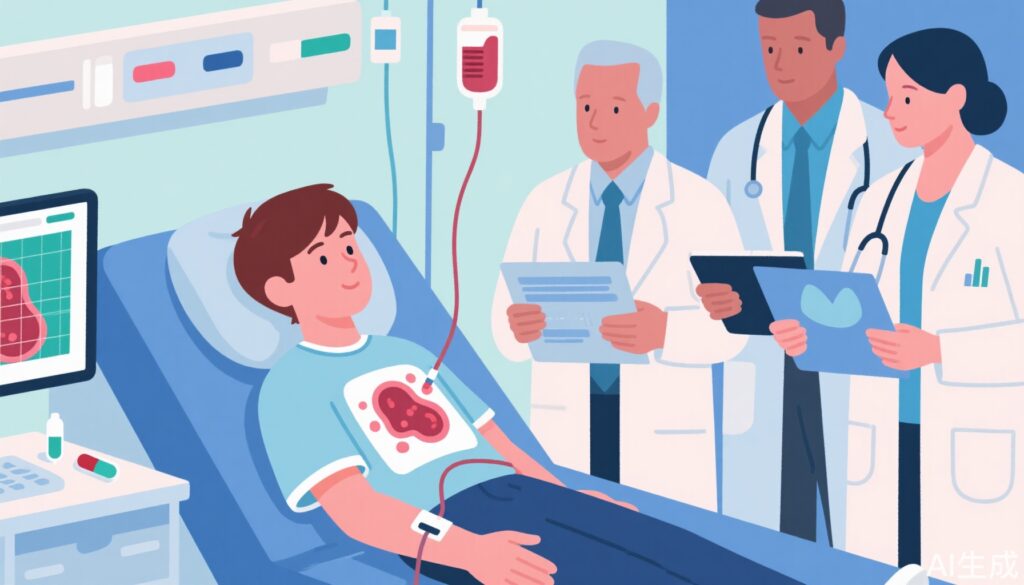Introduction
Large B-cell lymphoma (LBCL) is a common subtype of non-Hodgkin lymphoma, where patients with high-risk (HR) features often face less than a 50% chance of cure using the standard first-line (1L) R-CHOP chemotherapy regimen. High-risk features include elevated International Prognostic Index (IPI) scores, complex genetic rearrangements involving MYC and BCL2 and/or BCL6, and rapid disease progression or high tumor burden. Traditionally, patients with aggressive disease characteristics have been excluded from 1L clinical trials due to stringent screening protocols, limiting data on optimal treatment for this subgroup.
The COALITION study is a phase II, investigator-initiated trial designed to evaluate the safety, feasibility, and efficacy of combining the CD20xCD3 bispecific antibody glofitamab with either R-CHOP or Pola-R-CHP chemotherapy in younger patients (≤65 years) with high-risk LBCL. The study also aimed to minimize the interval between diagnosis and initiation of treatment, addressing the urgent clinical need in this population.
Methods
Eligible patients were aged 65 years or younger with biopsy-confirmed LBCL and at least one high-risk feature defined as IPI ≥3, National Comprehensive Cancer Network (NCCN)-IPI ≥4, or genetic rearrangements of MYC and BCL2 and/or BCL6. Participants first received one cycle of R-CHOP chemotherapy and were then randomized to receive five cycles of either glofitamab combined with Pola-R-CHP (n=40) or glofitamab combined with R-CHOP (n=40). Following chemotherapy, all patients received two cycles of glofitamab consolidation therapy. Patients could be enrolled either before or after the initial R-CHOP cycle, facilitating rapid treatment commencement.
The primary endpoints focused on safety and treatment deliverability, including the ability to complete planned therapy and maintain dose intensity. Secondary endpoints assessed response rates, including overall and complete response rates, and survival outcomes such as progression-free survival (PFS) and overall survival (OS).
Results
The study enrolled 80 evaluable patients with a median age of 58 years and a median total metabolic tumor volume of 842 cm³, indicative of high tumor burden. Treatment was initiated a median of 14 days post-diagnosis, reflecting the study’s goal of prompt therapy.
More than 95% of patients completed all prescribed therapy cycles, and the median relative dose intensity exceeded 94%, demonstrating high treatment adherence and feasibility. Cytokine release syndrome (CRS), a known side effect of bispecific antibodies, occurred in 21% of patients; all cases were grade 2 or below and were manageable with standard interventions.
The treatment achieved remarkable efficacy, with an overall response rate (ORR) of 100% and a complete response (CR) rate of 98%. After a median follow-up of 20.7 months, the estimated 2-year progression-free survival was 86%, and overall survival was 92%, indicating durable disease control in this high-risk population.
Discussion
The COALITION study provides compelling evidence that combining glofitamab with either Pola-R-CHP or R-CHOP chemotherapy is a feasible and highly effective first-line treatment option for younger patients with high-risk LBCL. The rapid initiation of therapy and high treatment completion rates highlight the regimen’s practicality in clinical settings.
The safety profile was manageable, with CRS events limited to lower grades and effectively controlled. The high response rates and durable survival outcomes suggest that adding glofitamab enhances anti-lymphoma activity beyond standard chemotherapy, likely due to its bispecific T-cell engaging mechanism targeting CD20-positive lymphoma cells.
These findings support further exploration of glofitamab-containing regimens in frontline LBCL treatment, potentially expanding options for patients traditionally considered difficult to cure. Ongoing and future studies may refine patient selection and optimize combination strategies to improve outcomes further.
Conclusion
The combination of glofitamab with R-CHOP or Pola-R-CHP chemotherapy is deliverable, safe, and yields high durable response rates in younger patients with high-risk, high-burden LBCL. This novel therapeutic approach represents a promising advancement in first-line treatment, warranting continued clinical investigation.
Reference
Minson A, Verner E, Giri P, et al. Glofitamab Combined With Pola-R-CHP or R-CHOP as First Therapy in Younger Patients With High-Risk Large B-Cell Lymphoma: Results From the COALITION Study. J Clin Oncol. 2025 Aug 10;43(23):2595-2605. doi: 10.1200/JCO-25-00481. Epub 2025 Jun 18. PMID: 40532125.


